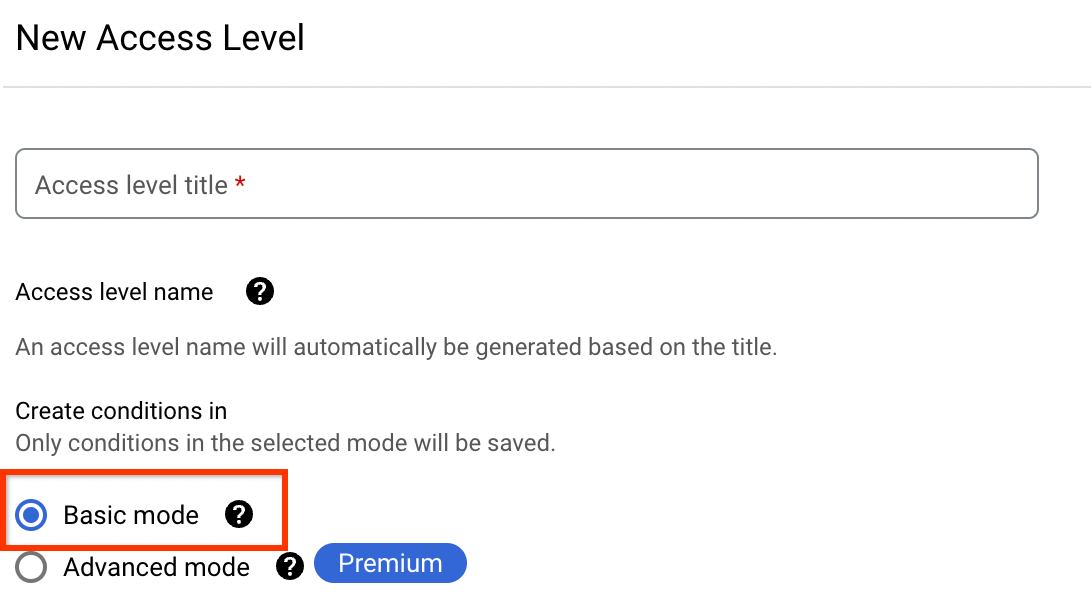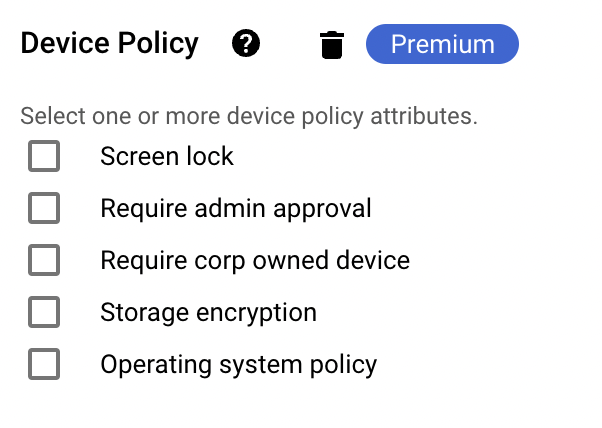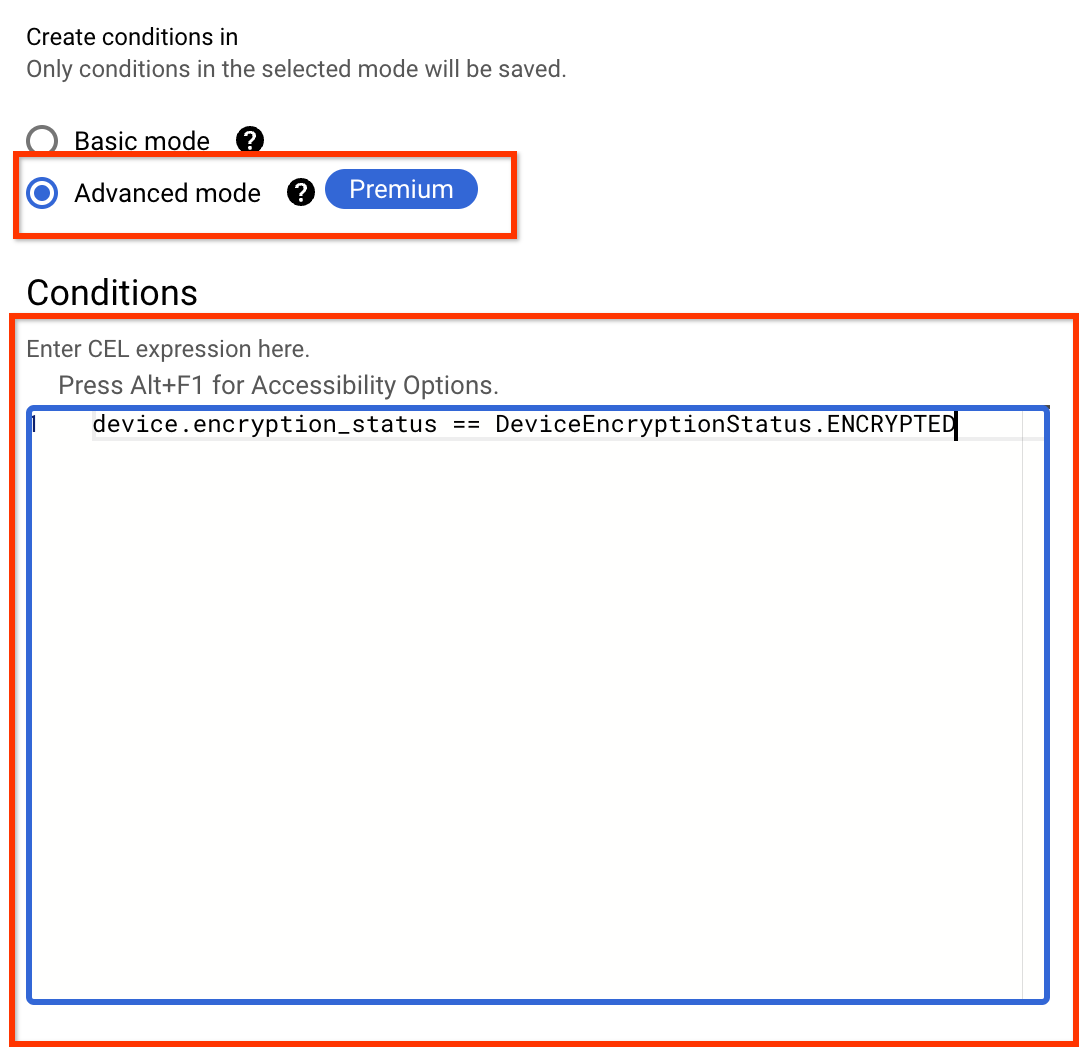This document shows how administrators can create access levels based on device attributes (device-based access levels) using Access Context Manager.
An access level is a set of attributes that is used to permit access to resources based on contextual information about the request. As an administrator, you can create basic access levels or custom access levels by using the device attributes collected by Endpoint Verification.
Before you begin
To complete the task on this page, you must have one of the following roles:
- Access Context Manager Admin (
roles/accesscontextmanager.policyAdmin) - Access Context Manager Editor (
roles/accesscontextmanager.policyEditor)
- Access Context Manager Admin (
Upgrade to the paid subscription of Chrome Enterprise Premium.
Create an access level
Console
In the Google Cloud console, go to the Access Context Manager page.
If you're prompted, select your organization.
On the Access Context Manager page, click Create access level.
In the New Access Level pane, create a basic access level or a custom access level. For instructions, expand the required section.
Create a basic access level
In the Access level title box, enter a title for the access level.
The title must be at most 50 characters, start with a letter, and can contain only numbers, letters, underscores, and spaces.
In the Create Conditions in section, select Basic mode
.

- In the Conditions section, select device attributes:
- Click Device Policy.
Select the required attributes.
For example, if you want to enforce admin approval on devices, select Require admin approval.


- Click Save.
The newly created access level is displayed on the Access Context Manager page.
Create a custom access level
In the Access level title box, enter a title for the access level.
The title must be at most 50 characters, start with a letter, and can contain only numbers, letters, underscores, and spaces.
- In the Create Conditions in section, select Advanced mode.
In the Conditions section, enter the expressions for your custom access level. The condition must resolve to a single boolean value.


To find the available device attributes for your CEL expression, see the device attributes collected by Endpoint Verification.
The following CEL expression allows access only from the encrypted devices:
device.encryption_status == DeviceEncryptionStatus.ENCRYPTEDFor examples and more information about Common Expression Language (CEL) support and custom access levels, see the Custom access level specification.
- Click Save.
The newly created access level is displayed on the Access Context Manager page.
gcloud CLI
To create access levels, use the gcloud access-context-manager levels create method.
Create a
.yamlfile.For a basic access level, specify device policy attributes for the access level.
Example: To limit access to only users with encrypted device storage, enter the following in the
.yamlfile.- devicePolicy: allowedEncryptionStatuses - ENCRYPTEDFor a custom access level, specify a CEL expression formatted as a single key-value pair:
expression: "CEL_EXPRESSION"Example: To limit access to only users with encrypted device storage and with the approved device status, enter the following in the
.yamlfile.expression: "device.encryption_status == DeviceEncryptionStatus.ENCRYPTED && device.is_admin_approved_device"
For a list of device policy access level attributes and their YAML format, see Device policy attributes. For a comprehensive YAML file of all possible attributes, see this example access level YAML file.
To find the available device attributes for custom level specifications, see Device attributes collected by Endpoint Verification.
Create the access level.
For a basic access level, run the following command:
gcloud access-context-manager levels create ACCESS_LEVEL_NAME \ --title=TITLE \ --basic-level-spec=FILE_NAME.yaml\ --policy=POLICY_NAME
For a custom access level, run the following command:
gcloud access-context-manager levels create ACCESS_LEVEL_NAME \ --title=TITLE \ --custom-level-spec=FILE_NAME.yaml\ --policy=POLICY_NAME
Where:
ACCESS_LEVEL_NAME is the unique name for the access level. It must have the following format:
accessPolicies/POLICY_ID/accessLevels/LEVEL_ID.LEVEL_ID is a name for the access level. The name must be at most 50 characters, start with a letter, and can contain only numbers, letters, and underscores.
TITLE is a human-readable title. It must be unique to the policy.
FILE_NAME is the name of the
.yamlfile. For a basic access level, it contains device policy attributes. For a custom access level, it contains a CEL expression formatted as a single key-value pair: `expression: "CEL_EXPRESSION".POLICY_NAME is the name of your organization's access policy.
You see output similar to the following:
Create request issued for: NAME Waiting for operation [accessPolicies/POLICY_NAME/accessLevels/NAME/create/1521594488380943] to complete...done. Created level NAME.
API
Create an access level by using the accessPolicies.accessLevels.create method.
Create a basic access level
Before using any of the request data, make the following replacements:
- POLICY_ID: the ID of your organization's access policy.
- LEVEL_ID: a name for the access level. The name must be at most 50 characters, start with a letter, and can contain only numbers, letters, and underscores.
- ACCESS_LEVEL_NAME: the unique name for the access level. It must have the following
format:
accessPolicies/POLICY_ID/accessLevels/LEVEL_ID. - TITLE: a human-readable title. It must be unique to the policy.
- DESCRIPTION: a description of the access level and its use.
- CONDITION: a list of requirements for the access level to be granted.
HTTP method and URL:
POST https://accesscontextmanager.googleapis.com/v1/{parent=accessPolicies/POLICY_ID}/accessLevelsRequest JSON body:
For basic access levels:
{
"name": ACCESS_LEVEL_NAME,
"title": TITLE,
"description": DESCRIPTION,
"basic": {
"conditions": [
{
CONDITION
}
],
}
},
}
To send your request, choose one of these options:
curl
Save the request body in a file named request.json,
and execute the following command:
curl -X POST \
-H "Authorization: Bearer $(gcloud auth print-access-token)" \
-H "Content-Type: application/json; charset=utf-8" \
-d @request.json \
"https://accesscontextmanager.googleapis.com/v1/{parent=accessPolicies/POLICY_ID}/accessLevels"
PowerShell
Save the request body in a file named request.json,
and execute the following command:
$cred = gcloud auth print-access-token
$headers = @{ "Authorization" = "Bearer $cred" }
Invoke-WebRequest `
-Method POST `
-Headers $headers `
-ContentType: "application/json; charset=utf-8" `
-InFile request.json `
-Uri "https://accesscontextmanager.googleapis.com/v1/{parent=accessPolicies/POLICY_ID}/accessLevels" | Select-Object -Expand Content
You should receive a JSON response similar to the following:
{
"name": "operations/accessPolicies/84961948973/accessLevels/deviceEncrypted/create/1666896068847514",
"metadata": {
"@type": "type.googleapis.com/google.identity.accesscontextmanager.v1.AccessContextManagerOperationMetadata"
},
"done": true,
"response": {
"@type": "type.googleapis.com/google.identity.accesscontextmanager.v1.AccessLevel",
"name": "accessPolicies/84961948973/accessLevels/deviceEncrypted",
"title": "accessPolicies/84961948973/accessLevels/deviceEncrypted",
"basic": {
"conditions": [
{
"devicePolicy": {
"allowedEncryptionStatuses": [
"ENCRYPTED"
]
}
}
]
}
}
}
Create a custom access level
Before using any of the request data, make the following replacements:
- POLICY_ID: the ID of your organization's access policy.
- LEVEL_ID: a name for the access level. The name must be at most 50 characters, start with a letter, and can contain only numbers, letters, and underscores.
- ACCESS_LEVEL_NAME: the unique name for the access level. It must have the following
format:
accessPolicies/POLICY_ID/accessLevels/LEVEL_ID. - TITLE: a human-readable title. It must be unique to the policy.
- DESCRIPTION: a description of the access level and its use.
- CEL_EXPRESSION: A CEL expression evaluating to a boolean.
HTTP method and URL:
POST https://accesscontextmanager.googleapis.com/v1/{parent=accessPolicies/POLICY_ID}/accessLevelsRequest JSON body:
{
"name": ACCESS_LEVEL_NAME,
"title": TITLE,
"description": DESCRIPTION,
"custom": {
"conditions": [
{
"expr": {
CEL_EXPRESSION
}
}
]
}
},
}
To send your request, choose one of these options:
curl
Save the request body in a file named request.json,
and execute the following command:
curl -X POST \
-H "Authorization: Bearer $(gcloud auth print-access-token)" \
-H "Content-Type: application/json; charset=utf-8" \
-d @request.json \
"https://accesscontextmanager.googleapis.com/v1/{parent=accessPolicies/POLICY_ID}/accessLevels"
PowerShell
Save the request body in a file named request.json,
and execute the following command:
$cred = gcloud auth print-access-token
$headers = @{ "Authorization" = "Bearer $cred" }
Invoke-WebRequest `
-Method POST `
-Headers $headers `
-ContentType: "application/json; charset=utf-8" `
-InFile request.json `
-Uri "https://accesscontextmanager.googleapis.com/v1/{parent=accessPolicies/POLICY_ID}/accessLevels" | Select-Object -Expand Content
You should receive a JSON response similar to the following:
{
"name": "operations/accessPolicies/84961948973/accessLevels/sampleCustomAccessLevelName/create/1666936427127701",
"metadata": {
"@type": "type.googleapis.com/google.identity.accesscontextmanager.v1.AccessContextManagerOperationMetadata"
},
"done": true,
"response": {
"@type": "type.googleapis.com/google.identity.accesscontextmanager.v1.AccessLevel",
"name": "accessPolicies/84961948973/accessLevels/sampleCustomAccessLevelName",
"title": "accessPolicies/84961948973/accessLevels/sampleCustomAccessLevelTitle",
"custom": {
"expr": {
"expression": "device.encryption_status == DeviceEncryptionStatus.ENCRYPTED"
}
}
}
}
For more information about creating access levels with various conditions and access level dependencies, see Create a basic access level.
